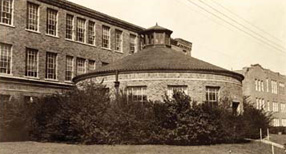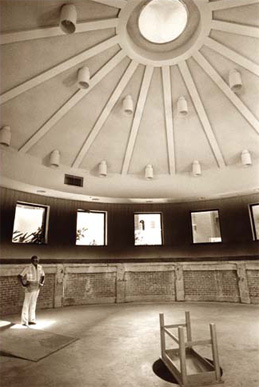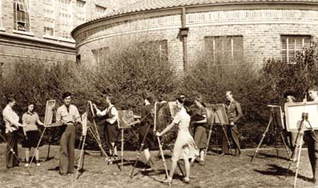The cow might not have jumped over the moon in the Roundhouse, but both have made an appearance there through the years.
 Built in 1928, the circular building connected to the south side of Preston Hall was originally intended for livestock viewing. It served that role—and several others—before becoming a planetarium in 1981.
Built in 1928, the circular building connected to the south side of Preston Hall was originally intended for livestock viewing. It served that role—and several others—before becoming a planetarium in 1981.
The structure was built as part of what was called the Science Building when UT Arlington was known as North Texas Agricultural College and was part of the Texas A&M University System.
An editorial in the Jan. 17, 1928, issue of The Shorthorn reads, “There is to be an annex in the rear (of the building) which is to be built so that it can be used for a livestock judging ring. This is an A&M College and agricultural facilities are rightfully being enlarged.”
Formal opening of the Science Building and the round Animal Husbandry annex was held Oct. 29, 1928.
 |
| An inside view of the Roundhouse shortly before its conversion to a planetarium in 1981. |
The building featured Romanesque Revival architecture, a popular style of the 1920s, and the annex contained seats along the walls with windows so those outside could see in. The floor was depressed to enable better viewing.
According to reports in The Shorthorn, the annex was later used as a slaughterhouse until the ag department moved out in 1940. Administrators envisioned lectures and rehearsals there, but poor acoustics scrapped the plan.
Instead, a false floor was added and art classes scheduled. Art Professor Howard Joyner taught camouflage there during World War II, training military students in the use of color to prevent identification by aerial photography.
First mention of the building being called the Roundhouse apparently occurred in the 1950 Reveille, the school’s yearbook. It was about this time that Science Hall was built, and the building that included the Roundhouse was renamed Preston Hall and converted to classrooms.
After the Art Department left in 1963, the Roundhouse was transformed into offices for the History Department. It served that purpose for several years before art Professor Bill Stegall moved in with his art printing lab.
In a 1981 issue of UTA (now UTA Magazine), Stegall said, “I needed a single room, and I had to teach my course divided into nine single rooms. When I checked roll, I had to go to nine different rooms.”
In 1975 physics Professor Ulrich Herrmann proposed that the Roundhouse become a planetarium. It took awhile, but money was eventually appropriated and the planetarium opened in 1981.
 |
| Professor Howard Joyner's outdoor painting class outside the Roundhouse (circa 1946). |
“People often ask why the planetarium has windows,” said physics Professor Roy Rubins, who teaches astronomy. The windows are still there but have been covered with paneling on the inside.
The Roundhouse planetarium seats 60 and is known for its public offerings, including Halloween and holiday programs organized by new planetarium Director Robert Bonadurer. It will continue to be used for smaller shows.
“We have had more shows in there lately,” Bonadurer noted, “just as kind of a teaser prior to the opening of the new planetarium.”
A 165-seat planetarium (see story) opens in the new Chemistry and Physics Building in March.
And business will continue as usual in the Roundhouse. With today’s technology, you still might see that cow soaring through space.
— Jim Patterson
| Archives
| Alumni Association |
Giving to UTA | UTA
Home Copyright © 2006 UTA Magazine. All rights reserved. |
